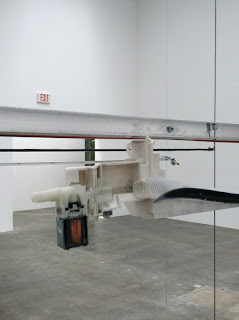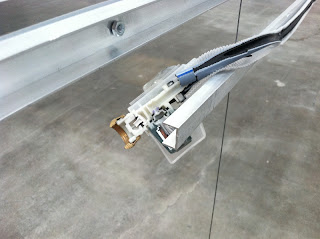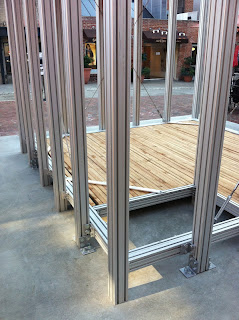dayoutlast is a record of my direct engagement with mostly contemporary art, mostly Los Angelean.
As this blog has evolved since its 2010 inception, so has my perspective. What I once perceived as central within the investigation was what was central, literally, within the photographic frame that I shared here. While still an important consideration, such thinking has also given way to more peripheral considerations, ones also accompanied occasionally by text (written manifestation of thought) and the oscillations between them. What's missing here are larger unknowns surrounding issues of presentation and representation; the amount of time and space it actually takes to accomplish such first-hand observations; and the quandaries between documentation and interpretation.
Despite my attempt to communicate here with image and text what is essential in some respect about the artwork, neither representation should ever be considered a substitution for the primary viewing experience. Of course, occasionally there are exceptions.
Most of the time, these posts are merely remnants---residual fragments---from my last day out.
Friday, August 31, 2012
Thursday, August 30, 2012
"Mash Up" @ L&M
 |
| Sterling Ruby, "BC (3786)," 2012, Collage, paint, bleach, glue, fabric, on wood |
 |
| Paul McCarthy, "Carpet (D)," 2009-2011, Clay, plastic, and gloves on carpet. |
 |
| Aaron Curry, "Bag of Sags," 2012, Collage and gouache on board |
 |
| Mark Bradford, "Untitled (series of seven unique sculptures)," 2009, Mixed media, paper mache and collage |
 |
| David Hammons, "Untitled," 2009, Mixed Media |
Thursday, August 23, 2012
Modern Optic (Leslie Ross-Robertson) @ Fifth Floor
My photos do not do justice to the surface beauty---paper quality, debossing and subtle range of color--- of these prints. Regardless, I share them here anyway. Find others at www.modern-optic.com
"Standard Operating Procedures" Curated by Piper Marshall @ Blum & Poe
 |
| Alan Uglow, Portrait of a Standard-Blue, 2000, Screenprint on canvas, 84 1/4 x 72 x 6 inches installed |
 |
| Sean Paul, Arrangement 15, Front/Top/Bottom/Right/Left/Back/Front-Right/Top2, 2012 Oil and acrylic on extra fine linen, 40 x 60 x 1 1/8 inches |
 |
| Yngve Holen, Parasagittal Brain, 2012, Left half of water cut garden hose with spray nozzle, left contact lense, 4 x 293 1/2 x 2 inches 62 3/4 x 293 1/2 x 2 inches installed |
 |
| Parasagittal Brain (alternate installation view) |
 |
| Parasagittal Brain (detail), 2012, Right half of water cut garden hose with multi purpose spray gun, right contact lense, 7 1/2 x 293 x 2 inches 63 1/2 x 293 x 2 inches installed |
 |
| Parasagittal Brain (detail), 2012, Left half of water cut garden hose with spray nozzle, left contact lense, 4 x 293 1/2 x 2 inches 63 1/2 x 293 x 2 inches installed |
 |
| Parasagittal Brain (right nozzle detail) |
 |
| Parasagittal Brain (left detail) |
 |
| Parasagittal Brain (detail) |
 |
| Parasagittal Brain (detail) |
 |
| Parasagittal Brain (detail) |
 |
| Helen Marten, Dust and Piranhas, 2011, Animations video, sound Format variable; TRT: 25 minutes 25 seconds |
Aside from the "standard" disclaimer about over-crowded group shows, perhaps especially of the summer variety, there were a few artworks in this show worth considering discretely despite the difficulties in viewing them as such. Regarding such challenges in particular, Sean Paul's paintings with a speaker from another piece inserted in between the work and the slightness of Yngve Holen's sculptural installation---muddled by other works in the room---were not served well by such dense installations, unless, of course, we were to consider the show as such and assumer a larger narrative where "standard operating procedures" equals chaos. I certainly hope not; I wouldn't think so. We've seen enough attempts at "standardizing" in this region as of late. That said, the images of the four artist's I include here represent what I think are nice moments and positions within viewing them. Questions about presentation and re-presentation, systematic actions, bodily currents, and reflexivity all make for what I would propose could be "standard" (read: perpetual) human concerns for less uniform purposes in another show, just these four.
Kevin Appel @ Susanne Vielmetter
My own act of looking, aided by camera and notes reminded me of the tenuous space of representation between media as well as place, in this instance "displace" as I am asked to seek artifacts of a distant landscape though all I end up thinking about is the painting facture, which indeed should be thought about as artifact. Occasionally I find grain or perhaps surface injury via nails, but mostly I think of surface layers and movements from a middle toward an edge and back where any quest for image is supplanted by another technical move (save the one that appears with a photographic horizon where I begin to think, concretely, about a ground, not a painted one just a memory of a distant space. Pictorial of other artists were as follows (as they came to mind): Gerhard Richter, Nate Hylden, John McCallister, Richard Aldrich, Roy Lichtenstein, Adolph Gottlieb, and John Divola.
Subscribe to:
Comments (Atom)


























































